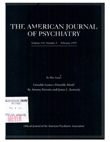Diagnostic comorbidity in persons with suicidal ideation and behavior
Abstract
OBJECTIVE: An initial finding of heightened risk of suicidal ideation or behavior among individuals in a random community sample who met diagnostic criteria for panic disorder or panic attacks was not replicated in later studies of both general and specific groups of psychiatric outpatients. The present study represented another effort to validate the finding. METHOD: The participants included 209 outpatients who had attempted suicide or were at high risk for continued suicidal behavior or eventual suicide. All subjects were evaluated with a structured clinical interview for assigning DSM-III-R diagnoses, the Modified Scale for Suicidal Ideation, the suicidal ideation subscale of the Suicide Probability Scale, and the Beck Hopelessness Scale. RESULTS: The findings indicated the relative complexity and importance of diagnostic comorbidity among these suicidal subjects. Mood disorders were the most frequent primary diagnoses, followed by phobias, posttraumatic stress disorder (PTSD), generalized anxiety disorder, and panic disorder. Panic disorder was not present as an isolated, independent diagnosis; on the contrary, all of the patients with panic disorder also received at least one additional comorbid diagnosis. Mean scores for suicidal ideation and hopelessness were greatest for patients with current comorbid primary mood disorder and panic disorder. However, a critical and equally important role was played by comorbid PTSD, generalized anxiety disorder, and phobias. CONCLUSIONS: The findings represent another failure to validate, with a specific clinical group, panic disorder as an independent risk factor for suicidal ideation or behavior. However, they highlight the possibility that panic disorder and other anxiety disorders are risk factors when they co-occur with a primary mood disorder.
Access content
To read the fulltext, please use one of the options below to sign in or purchase access.- Personal login
- Institutional Login
- Sign in via OpenAthens
- Register for access
-
Please login/register if you wish to pair your device and check access availability.
Not a subscriber?
PsychiatryOnline subscription options offer access to the DSM-5 library, books, journals, CME, and patient resources. This all-in-one virtual library provides psychiatrists and mental health professionals with key resources for diagnosis, treatment, research, and professional development.
Need more help? PsychiatryOnline Customer Service may be reached by emailing [email protected] or by calling 800-368-5777 (in the U.S.) or 703-907-7322 (outside the U.S.).



